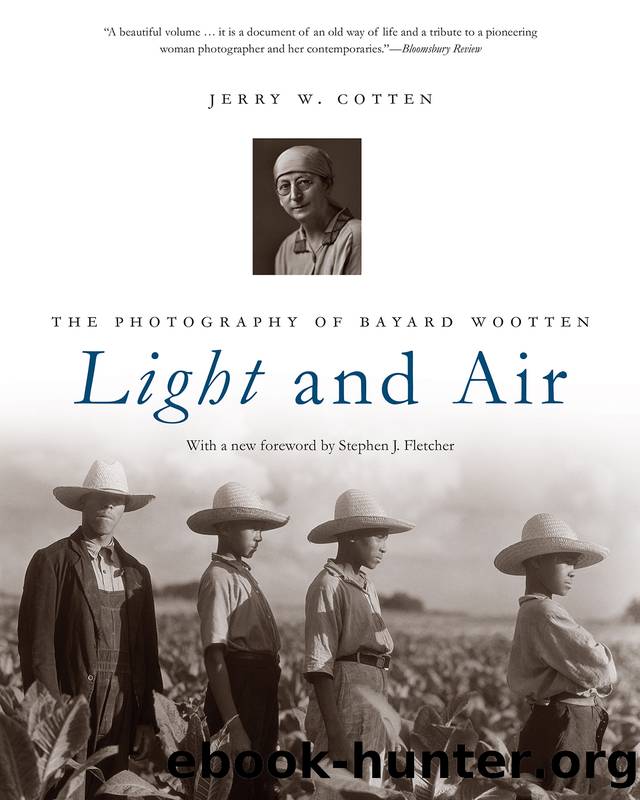Light and Air by Jerry W. Cotten

Author:Jerry W. Cotten [Cotten, Jerry W.]
Language: eng
Format: epub
ISBN: 9780807824450
Publisher: UNC Press
Published: 2017-09-15T00:00:00+00:00
FIGURE 28
At work in the studio during the 1930s, Wootten gingerly reaches for a piece of glass for use in framing a photograph. (North Carolina Collection)
The FSA photographers who worked in North Carolina included Marion Post Wolcott, Jack Delano, Dorothea Lange, and Arthur Rothstein. Wolcott, Delano, and Lange came to the state under the auspices of the FSA and the Institute for Research in Social Science at the University of North Carolina. The Instituteâs director was Howard W. Odum, a respected sociologist and prolific writer. Odum sat for portraits at Woottenâs studio, but it seems unlikely that she shared his progressive ideas on social planning and race relations.
Woottenâs racial attitudes were typical of those prevalent among many whites of her generation. Born in 1875, she reached maturity at a time when Jim Crow laws were being passed across the South. In 1900, when Wootten was twenty-five, North Carolina voters approved a constitutional amendment that disfranchised African Americans. Some of her photographs reflect the racial stereotypes of the period, and as late as the 1930s she gave the title âPickaninniesâ to an exhibition photograph of black children. Woottenâs images, however, probe the character of those she photographed whether they were black or white. With few exceptions, she depicted subjects with dignity and charm even when bare feet and tattered clothes spoke of unseen hardships.
Howard Odum and FSA Historical Unit chief Roy Stryker had deep roots in academia and shared a social perspective to which Wootten did not subscribe. Stryker had taught economics at Columbia University before joining the FSA, and Odum earned his doctoral degree in sociology at Columbia. In the 1930s much of Odumâs work at the University of North Carolina focused on the study of regionalism. He identified a thirteen-county area in north central North Carolina and south central Virginia as a âsubregional laboratory for social research and planning.â Odum and his colleagues at North Carolina identified places and subjects for a photographic study of the subregion, and in 1939â40 Strykerâs photographers came to the area.
They photographed some of Woottenâs traditional subjectsârural life, farm and domestic scenes, and people at the bottom of the economic ladder. Tobacco farming, a major source of livelihood in the area and a defining element in the regionâs culture, received heavy emphasis. The FSA photographs appear unrehearsed and provide an honest representation of rural and small town life. There is no pretense of artistry. In contrast to Wootten, who kept only sparse records, the FSA photographers usually noted who and what they photographed, along with dates and locations. This information significantly enhances the documentary value of their images.
In the spring of 1940 the Institute for Research in Social Science hosted a conference in Chapel Hill on âpopulation research, regional research, and the measurement of regional development.â Roy Stryker attended the meeting, and the FSA prepared an exhibit from the work carried out by Wolcott, Delano, and Lange.
The exhibition may not have been open to the general public, for it received no local publicity. Even
Download
This site does not store any files on its server. We only index and link to content provided by other sites. Please contact the content providers to delete copyright contents if any and email us, we'll remove relevant links or contents immediately.
Shoot Sexy by Ryan Armbrust(17663)
Portrait Mastery in Black & White: Learn the Signature Style of a Legendary Photographer by Tim Kelly(16957)
Adobe Camera Raw For Digital Photographers Only by Rob Sheppard(16907)
Photographically Speaking: A Deeper Look at Creating Stronger Images (Eva Spring's Library) by David duChemin(16623)
Bombshells: Glamour Girls of a Lifetime by Sullivan Steve(13979)
Art Nude Photography Explained: How to Photograph and Understand Great Art Nude Images by Simon Walden(12977)
Perfect Rhythm by Jae(5327)
Pillow Thoughts by Courtney Peppernell(4215)
The Book of Joy by Dalai Lama(3904)
Good by S. Walden(3490)
The Pixar Touch by David A. Price(3369)
A Dictionary of Sociology by Unknown(3032)
Fantastic Beasts: The Crimes of Grindelwald by J. K. Rowling(2997)
Humans of New York by Brandon Stanton(2835)
Stacked Decks by The Rotenberg Collection(2812)
Read This If You Want to Take Great Photographs by Carroll Henry(2664)
On Photography by Susan Sontag(2578)
Insomniac City by Bill Hayes(2501)
Photographic Guide to the Birds of Indonesia by Strange Morten;(2492)
